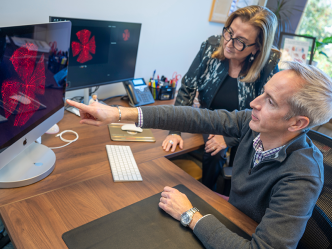The relative cost, benefits, and complications of three minimally invasive techniques for reducing or eliminating symptomatic uterine fibroids are being compared in women who don’t have cancer and want to preserve their uterus.
The Medical College of Georgia at Georgia Regents University and GRHealth are among about a half-dozen centers nationally comparing the standard approaches of surgically removing fibroids or occluding the blood vessels that feed them to the newer global fibroid ablation, said Dr. Kelli Braun, obstetrician and gynecologist at MCG and GRHealth and a Principal Investigator on the study.
Much like cardiac ablation, which destroys areas of the heart generating abnormal, sometimes dangerous rhythms, global fibroid ablation uses radiofrequency energy, a combination of electric and magnetic energy, to shrink and/or destroy fibroids so they no longer produce painful pressure or cause excessive bleeding. “It kind of involutes and destroys itself. It may not go away 100 percent, but it is no longer active,” Braun said.
The TRUST Study (Treatment Results of Uterine Sparing Technologies) following 300 women for five years, is funded by Halt Medical Inc., the medical device company that developed global fibroid ablation. The Food and Drug Administration approved the company’s Acessa™ system for fibroids in 2012.
Researchers are comparing the three treatments’ direct costs, such as hospital stay, procedure costs, complications, safety, and the need for additional therapy. They also are comparing indirect costs such as recovery rate and time lost from work as well as quality of life measures such as symptom severity, including bleeding, and general health outcomes.
With global fibroid ablation, physicians access the uterus through two small incisions in the abdomen, then use ultrasound to verify the location and number of fibroids. Next, a grouping of electrodes, which Braun likens to fingers, are deployed directly into each fibroid; how far depends on the size. The electrodes then generate heat, the level and duration depending on fibroid size. The approach can be used on numerous fibroids simultaneously, including some larger ones. The fibroids shrink over a period of months, Braun said.
This approach is being compared to a myomectomy, where the fibroid is removed either through a standard abdominal incision or laparoscopically, depending primarily on the size of the growth. Myomectomy has been widely considered the best surgical option for women wanting to preserve their fertility.
The third technique in the study, uterine artery embolization, involves an interventional radiologist blocking the major blood vessels supplying the fibroid by injecting small particles, often polyvinyl alcohol, so they gradually shrink and potentially die.
The uterus is essentially a large muscle that expands to accommodate a growing fetus, expels a baby when it’s time, and then shrinks back down. “The uterus is made of muscle, and in the case of fibroids, one of the cells essentially goes haywire and forms a ball. It can be small or grow significantly large,” Braun said, noting the condition affects up to 75 percent of women. Most fibroids are small, some undetectable on physical exam, and mostly asymptomatic. However, Braun cites a recent patient whose large fibroid pushed her uterus under her breastbone.
Why fibroids occur, never mind why they occur so frequently, is not well understood, but these estrogen-sensitive growths tend to run in families, almost always occur before menopause, and are almost always noncancerous.
Fibroids don’t actually bleed rather they cause bleeding by disrupting the normal architecture of the uterus. Some women also will report a feeling of fullness and might even feel a bulge if the fibroid is large enough, Braun said.
“We typically try medical therapy first,” she said, which may include birth control pills or an intrauterine device containing progestin, a synthetic version of the female hormone progesterone, that can help decrease menstrual bleeding. Neither treatment addresses current size or potential discomfort of a fibroid. “If patients fail medical management or if pressure is the real issue, the only other option really is to take the fibroid out,” she said
Braun notes that women unconcerned about reproduction often opt for a hysterectomy. In fact, fibroids are the major reason for the procedure. Hysterectomy is the only acceptable therapy for rapidly growing fibroids that may be cancerous, she notes.
 Augusta University
Augusta University



